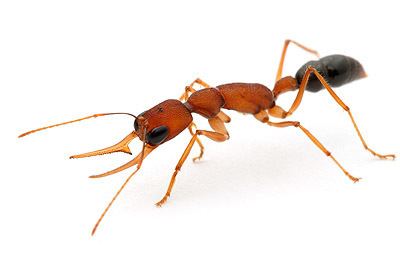Subfamily Ponerinae Higher classification Harpegnathos Order Hymenopterans | Family Formicidae Genus Harpegnathos Rank Species | |
 | ||
Similar Harpegnathos, Ant, Insect, Camponotus floridanus, Podomyrma | ||
Harpegnathos saltator formiga saltadora
Harpegnathos saltator, sometimes called the Indian jumping ant or Jerdon's jumping ant, is a species of ant found in India. They have long mandibles and have the ability to leap a few inches. They are large eyed and are active predators that hunt mainly in the early morning hours. The colonies are small and the difference between workers and queens is very slight.
Contents

Subspecies
Habits

Unlike other ants, they are seen singly or in small groups and their colonies consist of very small numbers of individuals. They are also unusual amongst ants in that the queen-worker difference is very limited and some workers can mate and lay fertilized eggs just like the queen. These workers are termed gamergates. New colonies are founded independently by single queens, and on aging they are replaced by several gamergates. The gamergates copulate with males from their own colonies and, being inbred, are related to the original founding queen. Colonies are very small, and they never undergo fission to form new colonies.
The workers limit the number of reproductives in the colony by policing new workers that try to lay eggs when an active queen or established gamergates are present. Workers use alarm pheromones which include 4-methyl-3-heptanone, 4-methyl-3-heptanol and isopentyl isopentanoate. H. saltator, like many species of ant, produces 4-methyl-3-heptanone from mandibular glands. Dufour's gland secretions have been found to include a complex mixture of linear hydrocarbons from C15 to C25, with (Z)-9-tricosene being the main constituent, along with other minor constituents like tetradecyl propionate and traces of tetradecyl acetate and dodecyl acetate. Both the secretions from the postpharyngeal glands and the cuticular wax include methyl esters of common fatty acids.
Their leaps are accomplished by synchronized abduction of the middle and hind pairs of legs. They can jump up to 2 cm high and 10 cm long. These leaps are made not only to escape, but also to catch flying prey. The workers forage only during the cool hours of the morning and afternoon with a lull in activity during mid day.
The nest entrance is usually a low mound on the ground with the entrance surrounded by twigs and leaves. The nest entrance is closed by the ants in the evening, and is reopened in the day. The main chamber has a funnel-like opening in the antechamber, and this structure is believed to prevent flooding of the main chamber.
A study of the genome and expressed genes found that the production of enzymes that slow aging (telomerase and sirtuin deacetylases) are increased when workers turn into queens.
Description
The following is the original description by T. C. Jerdon.
The following is the taxonomic description from C. T. Bingham's Fauna of British India (Hymenoptera - Volume 2):
